By Kelly Galfand, JOY IN YOUR SPACE, 610-896-6896
My role as organizer usually involves helping people:
• live with less
• have more within easy reach
• love what they store.
One popular area I organize is wardrobe closets. Sometimes I’m hired to fix a physical problem; I solve storage challenges. Sometimes I am the necessary support as someone decides:
• what to keep
• where to donate or sell
• how to let clothes go.

In my experience, even when someone commits to trimming their wardrobe, there is one item they want to get rid of but (in their words) “can’t!” In these situations, what’s really behind their “can’t” is guilt.
When I hear a closet client say “I can’t get rid of this,” I know the clothing in question was either expensive, a gift, or it holds sentimental value.
• If the item was expensive… and they haven’t worn it (ever or enough), the struggle is about throwing good money away. But honestly, they’re wasting more money by storing this item. Waiting too long to resell something is not smart; the resale market pays more for recent purchases.
• Check out resale avenues like TheRealReal, PoshMark, Clothes Mentor, Plato’s Closet, and ThredUp depending on the item’s value.
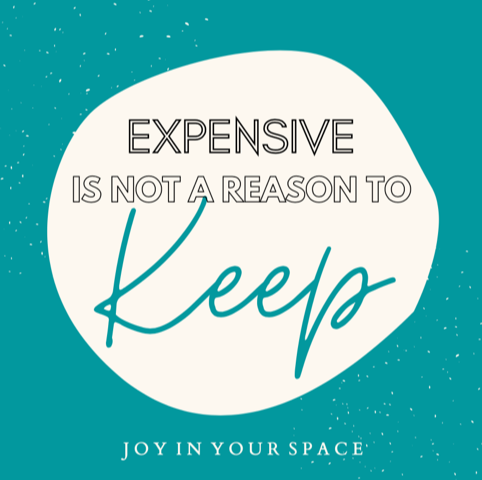
• If the item was a gift… from someone they love, their love for the person is getting in the way of their ability to decide what they want in their life. They sometimes think that letting the item go is akin to rejecting the gift-giver’s love, kindness, or generosity. Trust me, your favorite aunt knows you love her even if you don’t love the winter hat she gave you. I always reassure clients that no one gives a gift in order to burden the recipient. A recipient’s only responsibility is to be gracious in accepting the gift.
• —You can always donate the item or its value to a charitable organization the gift-giver supports to lessen the pain of letting the item go from your life. Let it be a gift that keeps on giving — to someone else!

• If the item holds memories it will fall into one of two categories:
• Clothing from the person’s own life (even if it was someone else’s at some point)
When I come across these sentimental clothes, the first question I ask is: Will you still wear it? If the answer is “yes,” it can stay.
If the answer is “no,” then I suggest the t-shirt, wedding gown, or cheerleading skirt move to a spot more suitable to memories and nostalgia.
• Clothing that holds memories may have belonged to a deceased loved one. I help people navigate these sensitive areas often. What I counsel, is to keep only the sweatshirts, t-shirts, or hats that meant something to the departed and mean something still to you if you have room for it.
If it’s something you aren’t going to wear, display it to honor it in some way. Shadow boxes are wonderful conversation pieces and visual reminders of our ancestors’ legacies.
To me, your adored Uncle’s memory does not hinge on a single t-shirt…not even on his entire t-shirt collection. I recommend that if you let items go from your life (that belonged to someone you loved) decide how you will remember this person (in thought or deed) once you let the item go. Then be intentional in keeping their memory alive.
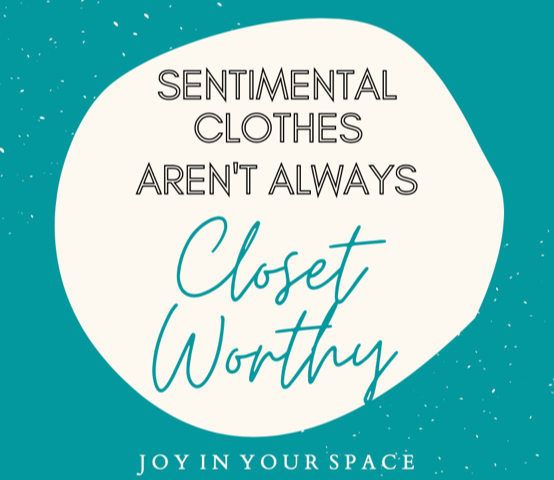
There are a lot of us who LOVE shoes. Why is that? Some shoes make us feel sexy or pretty while others feel like comfy slippers. They enhance our outfits and keep our feet safe. But when is “enough” more than enough?
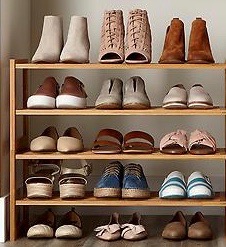
WHO owns the most shoes? Statistics say the average man owns 11 pairs of shoes and the average woman 27 pairs. In my profession (and closet) I see more than that but 27 or under is a good goal to work toward.
WHY let go of shoes? To free your closet of congestion so you can see what you own and start to wear those previously hidden treasures. To make getting dressed less stressful. To save money because you won’t re-buy what you already own but can’t locate.
WHAT to let go of: The rule of thumb is to let go of shoes you haven’t worn in a year. The hardest to let go of are the attractive ones you love the looks of but that hurt. Or how about the ones you spent a lot of money on? There is no point in keeping shoes you won’t wear, even if letting go pulls at your heartstrings. Consider taking a photo of them but say good-bye. Let go of those old favorites that are too worn out to wear. Ask yourself: If I didn’t already own them would I buy them?
WHEN to purge: Get in the habit of reviewing your shoes (and clothes) twice a year when you’re switching out the seasons.
WHERE to dispose of unwanted shoes:
HOW to store: You’ll want to store similar types of shoes together (winter/summer and/or dressy/work/casual). You’ll want your shoes to be as visible as possible with what you wear most often to be most easy to access.
♪♫ Your shoes were made for walkin’ and that’s just what they’ll do♩♪
either by you or those in need!

The answer is …. Sort of.
I don’t necessarily wear the EXACT SAME THING EVERY DAY, but yes, I have about 4-5 outfits that I wear ALL THE TIME.
Why do I do that?
As a business owner, mom and CFO and COO (and housekeeper and launderer …) of our household, I’ve got A LOT TO DO. So the last thing I want to waste my energy on is figuring out what the heck to wear.
So, my general formula is:
And that’s about it. There’s no magic formula. There’s no exact number of items. There are no rules.
Here’s a few things to try:
Pare it down
When you are at a stage in life where you’ve just got TOO MUCH TO DO, then DO LESS. Channel your inner Steve Jobs (black tee and jeans!), make one less decision, and kick your morning off right.
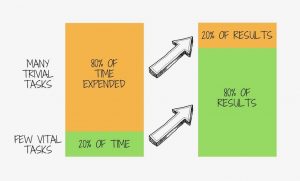 Have you ever gotten to the end of your day wondering what (if anything) of value you actually accomplished? If so, it may be time to pull out the 80/20 Rule!
Have you ever gotten to the end of your day wondering what (if anything) of value you actually accomplished? If so, it may be time to pull out the 80/20 Rule!
Professional organizers often apply the 80/20 Rule (a.k.a., the Pareto Principle or the Law of the Vital Few) to decluttering. For example, in a closet, determine the 20% of clothes you wear 80% of the time, purge the 80% of clothes you seldom or never use, and – voila! – you have space for clothes more like your favorite few.
The principle also applies to time. Most of us accomplish 80% of our best work in just 20% of our time, and fritter away 80% of our time doing…what? The key to really accomplishing our goals, to really making an impact, is to focus on the 20% of things we are really good at.
Determining our best 20% when it comes to clothes is pretty straightforward: pull everything out of the closet and start sorting: things I love (or not), things that fit (or not), things that make me look great (or not), etc.
But how do we determine our best 20% when it comes to work? Claire Diaz-Ortiz, in the book Design Your Day, suggests this similar pull-out-and-sort activity to find out:
First, get two pieces of paper. At the top of one write “Big Wins” and on the other write “Activities.”
On the “Big Wins” paper, list things that you’ve done in the past few years, personally or professionally, that have brought you the greatest joy, that have made you feel most alive, that have made you feel like you were in the sweetest of sweet spots. These could be things that happened just once, or continuing things.
On the “Activities” paper, list absolutely everything you do on a regular basis – fun or not fun, significant or not significant, necessary or unnecessary, whatever. Then sort these items into three categories: Things Only I Can Do, Things Someone Else Can Do, and Things I Should Stop Doing. (It might help to rewrite your activities on a fresh piece of paper with three columns headed with these categories.)
Next, cross-check. Things that appear on both your “Big Wins” list and your “Things Only I Can Do” list are your best 20%!
Now, set priorities:
As Diaz-Ortiz says, “ultimately, this activity is a mind-opening way to see where your time and work is really moving the needle and where you’re just running on the hamster wheel to stay busy.”
Let 2018 be the year where you focus on the few vital tasks that best get you to where you want to be.
80/20 your 2018!
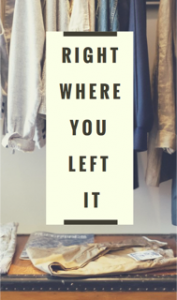 If being organized is not how you were raised but you’ve started to become more orderly, you may already know: it takes time getting used to “being organized.”
If being organized is not how you were raised but you’ve started to become more orderly, you may already know: it takes time getting used to “being organized.”
I learned this with a new client: Kim (not her real name) has struggled all her life to maintain a neat space. Her efforts go in waves and she has managed to live a really rich and creative life — but it hasn’t been easy. She’s lost a few things along the way. Paid her share of late fees for bills and penalties for misplaced parking tickets. And wasted time rewashing clothes after the dirty commingled with the clean.
When she was ready to stop this chaos…she called in a professional organizer.
She had 3 areas to organize:
• her wardrobe and bedroom
• her living room – including a desk area
• her hallway which had become an over-crowded storage space
We started in her bedroom because the mess was affecting her sleep. After 3 working sessions we had sorted through all of her clothes, cleared every surface (including the floor) of anything that didn’t belong, rearranged her dresser drawers and closet with zones for each type of clothing she needed in her life.
Moving on to the living room, Kim sheepishly told me a “funny” story about her missing slippers. The one constant in Kim’s life had been lots of weekends away to cabins with friends. In preparing to pack for one such weekend, she described how she had scoured her apartment looking for her slippers.
She checked ALL of her usual spots: under the coffee table, in the bathroom, kicked under the hallway table, in a pile behind the couch, tucked under her bed, tossed into a corner by her cat…she couldn’t find them anywhere.
She left for her weekend sans slippers in a bummed mood.
As soon as she got on the road to the cabin, it hit her. She couldn’t help but laugh out loud. Her slippers were right where we had left them — in their new home. They were in the bottom “bay” of the hanging shoe organizer we had installed in her closet.
It was a funny lesson to us both, that getting organized takes some getting used to! The motto of Kim’s story is: It’s easy to find what you need when you need it…when it is right where you left it.
Over the past 3 years, I’ve called three different NAPO colleagues to help me with my own organizing projects. Each time it was a fantastic experience. Not only did I get stuff done, I really got an appreciation for what it feels like to be the client AND as a result, I am a better Productivity and Organizing Consultant!
I hired professional organizers (or PO’s) to help me:
Here are some key takeaways from these sessions:
I was thrilled by what I got done: cleaned out an overwhelming amount of stuff so I could close down my mother’s apartment, became very tech-comfortable, and am feeling stylish and well-dressed like never before. The gratitude I feel towards these organizers is immense.
I close by urging all PO’s who have never hired another Professional Organizer to do so. Everyone can improve their productivity and up their level of being organized. And you’ll have much greater understanding and empathy for your clients!